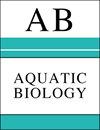驯化温度对濒危大眼鲑临界热极限和游泳性能的影响
IF 0.8
4区 生物学
Q3 MARINE & FRESHWATER BIOLOGY
引用次数: 7
摘要
热应激可以直接影响鱼类的生存,并通过几个过程间接影响鱼类种群,包括损害游泳性能。在伊利诺斯州,大眼丘鱼是一种国家濒危物种,在北美本土的北部地区正在消失。该物种的耐温性信息有限。本研究的目的是确定2种驯化温度对大眼鱼生产性能和行为的影响。为了实现这一目标,我们进行了2项测试:临界热最大值(CTmax)测试热容上限,以及临界游泳速度(Ucrit)和突发游泳能力的游泳性能测试。驯化温度从21℃升高到26℃,升高5℃,大眼球虫CTmax由32.8±0.4℃升高到36.4±0.9℃。在不同的驯化温度下,温度差异不大,两个驯化组的鱼可以游到10体长(BL) s−1以上。各组之间的爆发游泳时间也没有统计学差异,但26°C组的大眼鱼比21°C组的鱼游泳时间长27%。本研究结果有助于指导大眼鲑种群在热应激条件下的保护和恢复。本文章由计算机程序翻译,如有差异,请以英文原文为准。
Effects of acclimation temperature on critical thermal limits and swimming performance of the state-endangered bigeye chub Hybopsis amblops
Thermal stress can directly affect the survival of fishes and indirectly impact fish populations through several processes, including impaired swimming performance. Bigeye chub Hybopsis amblops is a state-endangered species in Illinois and is disappearing in the northern portion of its native range in North America. Limited temperature tolerance information exists on this species. The aim of this study was to define the impacts of 2 acclimation temperatures on the performance and behavior of bigeye chub. To accomplish this, we conducted 2 assays: critical thermal maximum (CTmax) testing for upper thermal tolerance limits, and swimming performance testing for critical swimming speed (Ucrit) and burst swimming ability. With a 5°C acclimation temperature increase from 21 to 26°C, the CTmax of bigeye chub increased from 32.8 ± 0.4°C to 36.4 ± 0.9°C. Ucrit was not different across acclimation temperatures, and fish from both acclimation groups could swim up to over 10 body lengths (BL) s−1. Burst swimming duration also did not differ statistically across groups, but bigeye chub from the 26°C group swam 27% longer in duration relative to fish from the 21°C group. Results from this study can help guide the protection and restoration of bigeye chub populations from thermal stressors.
求助全文
通过发布文献求助,成功后即可免费获取论文全文。
去求助
来源期刊

Aquatic Biology
生物-海洋与淡水生物学
CiteScore
2.70
自引率
0.00%
发文量
7
审稿时长
3 months
期刊介绍:
AB publishes rigorously refereed and carefully selected Feature Articles, Research Articles, Reviews and Notes, as well as Comments/Reply Comments (for details see MEPS 228:1), Theme Sections, Opinion Pieces (previously called ''As I See It'') (for details consult the Guidelines for Authors) concerned with the biology, physiology, biochemistry and genetics (including the ’omics‘) of all aquatic organisms under laboratory and field conditions, and at all levels of organisation and investigation. Areas covered include:
-Biological aspects of biota: Evolution and speciation; life histories; biodiversity, biogeography and phylogeography; population genetics; biological connectedness between marine and freshwater biota; paleobiology of aquatic environments; invasive species.
-Biochemical and physiological aspects of aquatic life; synthesis and conversion of organic matter (mechanisms of auto- and heterotrophy, digestion, respiration, nutrition); thermo-, ion, osmo- and volume-regulation; stress and stress resistance; metabolism and energy budgets; non-genetic and genetic adaptation.
-Species interactions: Environment–organism and organism–organism interrelationships; predation: defenses (physical and chemical); symbioses.
-Molecular biology of aquatic life.
-Behavior: Orientation in space and time; migrations; feeding and reproductive behavior; agonistic behavior.
-Toxicology and water-quality effects on organisms; anthropogenic impacts on aquatic biota (e.g. pollution, fisheries); stream regulation and restoration.
-Theoretical biology: mathematical modelling of biological processes and species interactions.
-Methodology and equipment employed in aquatic biological research; underwater exploration and experimentation.
-Exploitation of aquatic biota: Fisheries; cultivation of aquatic organisms: use, management, protection and conservation of living aquatic resources.
-Reproduction and development in marine, brackish and freshwater organisms
 求助内容:
求助内容: 应助结果提醒方式:
应助结果提醒方式:


